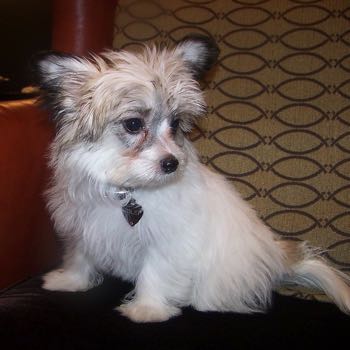Papitese

The Papitese is a small dog with long, silky fur and ears that typically stand semi-erect and is the result of crossing a Papillon and a Maltese. These good-natured dogs seem to have a smile across their lips at all times and have lively, vibrant eyes. Diminutive in size, they are sturdier than their Papillon parent but are undeniably delicate and should be supervised around large dogs and young children.
Faithful and loving, those in search of a dedicated pet should look no further. As well as becoming very attached to their family, the Papitese bonds well with other pets. Inquisitive and quick to learn, training this breed can be good fun and all the family can get involved.
About & History
The Papitese may also be called the Maltillon and is a small designer dog that was deliberately bred from the Papillon and the Maltese. Toy breed dogs are extremely popular nowadays, thanks to the current trend in society for apartment living and the desire to own dogs as pets, rather than as working animals.
There has been a recent surge in demand for first generation crosses with people in the market for a breed that is new and unusual. Most designer dogs have been developed within the last few decades and their creation is a ‘phase’ that is still going strong.
As the Papitese has only been around for a limited number of years, there is little to write about their history. However, the same cannot be said for their two parent breeds, who each have a rich and interesting history.
The Papillon
The Papillon is a European dog that likely came from working Spaniels, though was kept as a lap dog. Experts are unsure if the Papillon comes from France or Italy, though its name is French and means Butterfly. Kept by aristocrats and featuring in a large number of paintings and portraits over the years, the Papillon has always been a regal dog.
The Maltese
The Maltese is also a dog from continental Europe and though one may assume it hails from Malta, it was likely developed somewhat east of Malta. The original Maltese dog has been in existence for over 2,000 years and was once thought to have medicinal powers of healing. Nowadays, both the Papillon and Maltese are well-loved family pets and many participate in dog shows.
Appearance

A good mix of both its parents, the cute Papitese has long, silky fur and a lean, petite body. While the Papillon is very dainty with a delicate bone structure, the Papitese is somewhat more robust and sturdy. With bright brown eyes and a ‘smiling’ expression, this attractive dog always seems to be happy.
Their furry ears flop over, though not every individual will possess the ‘butterfly-shaped’ ears of their Papillon parent. Though small, they are not a brachycephalic breed and should possess a moderately-sized muzzle and good-sized black nose with wide-open nostrils.
The long and silky fur of the Papitese is one of their most attractive features and it may be a multitude of colours, including white, black and brown. In reality, the majority of dogs have a predominantly white body with brown or black patches. A tiny dog, most reach heights of between 20cm and 25cm when fully grown. At weights of only 3kg to 4.5kg, this is one of the smallest dogs around.
Character & Temperament
A sensitive and gentle soul, the Papitese requires a sensible owner who will meet its needs but not spoil or anthropomorphise it. The Papitese relies on human companionship for its happiness and enjoys being around people whenever possible. Sweet and affectionate, they are a rewarding pet to own and will show a great deal of loyalty.
Always on alert and a little high-strung, the Papitese will make sure you know when a new person or animal is arriving to the home. They have a high-pitched bark, which is hard to ignore. Owing to their small size, they do not make effective guard dogs – though they do not seem to realise this!
Very social, the Papitese gets on well with most other animals, even cats. The earlier they are socialised with the other household pets, the more accepting they will be of them. They are happiest when part of a pack – whether it be comprised solely of humans, or both humans and animals.
Small Dog Syndrome must be avoided at all costs as it not only makes the dog a terror around new people, it is also a sign of a dog that is unhappy and lacks confidence. Those with Small Dog Syndrome can be yappy and snappy and may take a dislike to certain family members or to strangers. Any initial signs of aggression or disobedience should be dealt with in the same way they would in a larger dog, and not encouraged or laughed at. Though small, the Papitese should be treated like any other big dog and not mollycoddled or babied.
Trainability
The curious and confident Papitese takes well to most forms of training and enjoys people pleasing. They are responsive to basic commands from an early age and can be taught a variety of tricks. Anecdotally, the Papitese can take longer than average to house-train, which may be due to their small bladder size. Owners should allow for this and provide them with plenty of ‘bathroom breaks’ when young.
Avoid any form of punishment or harsh reprimands when training the Papitese as they are overly sensitive and this may put them off the training task completely. They do best with constant praise and should be rewarded for consistently good behaviour.
Health
Most Papiteses are long-lived and enjoy good health, but there are several health conditions that we should be on the lookout for.
Patellar Luxation
Many small dogs are prone to ill-fitting knee caps that pop in and out of place. For some, they cope well and do not seem to suffer, whereas others can be affected to the extent that they struggle to get around and experience chronic pain. Diagnostic tests, including an orthopaedic exam and X-rays, can determine the extent of the problem.
Those that are only mildly affected may simply require joint supplements, physiotherapy and weight loss (if needed), while those that are suffering with high grade luxations may need surgery and on-going pain relief and anti-inflammatory medicine.
Heart Disease
There are a number of heart diseases that can affect the Papitese, including Mitral Valve Disease and Patent Ductus Arteriosus (PDA). A heart murmur may be heard by a vet when listening to the dog’s chest on a routine health check.
Thoracic X-rays and cardiac ultrasounds can be performed to assess the structure of heart and to determine the extent of the issue. Treatment will vary depending on which heart condition the dog has and how severe it is.
Porto-Systemic Shunt
When there is an abnormal blood connection between then liver and the rest of the body, this is known as a shunt. Blood which comes from the organs and should be processed by the liver is ‘shunted’ past. When this happens, toxins are not broken down appropriately and nutrients are not absorbed as they should be.
For most dogs, this is an abnormality that is present from birth. The liver will appear smaller than it should and the dog may experience nausea, stunted growth and neurological abnormalities. Liver function tests and specific imaging studies can help to diagnose the condition and surgery is often advised.
Exercise and Activity Levels
While small, the Papitese can be a high energy little guy and does enjoy being active. A few short walks every day should keep them satisfied and they also enjoy playing games and participating in canine activities, such as fetch or Frisbee.
Most will adapt well to apartment life or living within a small home and do not necessarily need access to a garden. As they are small and can get cold quickly in the winter, they should not be left outside for prolonged periods unless the weather is very mild.
Grooming
Though not entirely a hypoallergenic breed most only shed a small amount. Their silky fur must be brushed once daily to avoid matting and to keep it sleek and shiny. For some owners, this is too much of a commitment and they should consider a shorter-haired breed. Touted as a ‘clean’ dog, the Papitese does not really emit a ‘doggy’ odour and does not need frequent bathing.

